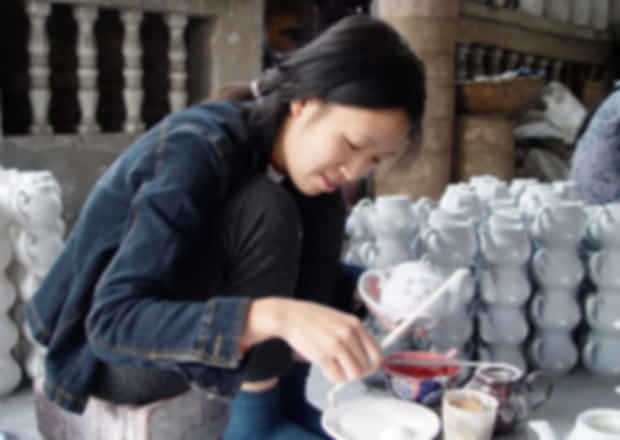Learning Vietnamese Handicrafts in Hoi An, Hanoi & Bat Trang: Tailoring, Lanterns, and Pottery -A Direct Guide for Beginners
Author
Arya Singh
Updated Date
November 21, 2025
Read
6 minutes

Vietnamese handicrafts are regarded as the first step of this country’s great artwork, showing the co-existence of precision and the perfect artistic style through the centuries. Its cultural charm lies not only in its landscapes but also in its centuries-old handicraft traditions that continue to inspire travellers and artists alike. Among the most celebrated are Hoi An’s silk lanterns, Hanoi’s tailoring workshops, and Bat Trang’s pottery classes, each offering a glimpse into Vietnam’s artistic soul.
Whether you’re a traveller looking for hands-on cultural experiences or a beginner eager to learn a new craft, this direct guide walks you through everything you need to know — from booking workshops and understanding materials to creating your very first handmade souvenir during your Vietnam tour package.
Vietnamese Handicrafts: An Introduction
The art of Vietnamese craftsmanship beautifully combines precision, patience, and heritage. These traditions are not just creative outlets — they are living expressions of community, continuity, and national pride.
| Craft | Cultural Significance | Location Highlights |
| Áo dài tailoring | Symbol of Vietnamese grace and identity | Hanoi & Hoi An |
| Hoi An lanterns | Represent happiness, hope, and prosperity | Hoi An Ancient Town |
| Bat Trang pottery | Reflects centuries of clay artistry and innovation | Bat Trang Village, near Hanoi |
Each of these traditional Vietnamese crafts invites you to connect with local artisans, understand their process, and walk away with your own piece of Vietnam’s heritage.
What to Expect in Vietnamese Craft Workshops

From fabric cutting and pattern-making to bamboo bending and clay shaping, every step of the process deepens your understanding of the craft’s rhythm. Here’s what you’ll typically create and learn:
| Craft | What You’ll Make | Duration | Difficulty | Key Skills |
| Áo dài or Tunic Tailoring | A fitted tunic or simple Áo dài top | 2–3 hours (short session) or multi-day course | Beginner to Intermediate | Measurement, cutting, sewing, fitting |
| Hoi An Lanterns | Collapsible silk lantern with LED light | 1–2 hours | Beginner | Bamboo framing, silk covering, safe lighting |
| Bat Trang Pottery | Wheel-thrown or hand-built bowl/vessel | 2–3 hours + glaze pickup later | Beginner to Intermediate | Clay centering, shaping, trimming, glazing |
Booking and Logistics: How to Join Craft Workshops in Vietnam
How to Book
You can walk into workshops in Hoi An and Bat Trang, as both are known for spontaneous participation. However, for structured sessions with English-speaking instructors, it’s best to book through Klook, GetYourGuide, TripAdvisor, or official Vietnam tourism sites.
Workshop Duration & Format
- Lantern making in Hoi An: 1–2 hours, hands-on, beginner-friendly
- Tailoring in Hanoi or Hoi An: 3–6 hours or spread across 2 days
- Pottery in Bat Trang: 2–3 hours, with optional glaze pickup after firing
Pre-Booking Checklist
- Confirm class size and the instructor’s language proficiency
- Check if materials are included
- Ask about shipping options for pottery
- Verify if firing or finishing is handled by the studio
Tailoring Workshops in Hoi An and Hanoi: The Art of the Áo Dài

The Áo dài, Vietnam’s iconic national attire, is a blend of artistry and precision. Learning to tailor it helps you appreciate the elegance behind its design.
Materials and Tools:
- Vietnamese silk or cotton from local markets
- Sewing machine, scissors, ruler, iron, pins, and pattern paper (usually provided)
Learning Process:
In Hoi An, sessions focus on hands-on creation, measuring, drafting, and sewing a tunic or top. In Hanoi, classes emphasize pattern fitting and tailoring precision, often taught by experienced local seamstresses.
Pro Tips:
- Iron after each step for clean seams
- Practice stay-stitching curves before final sewing
- Focus on minor fit adjustments; they make a huge difference
Hoi An Lantern Making Workshop: Light, Symbolism & Creativity
Hoi An lanterns are among Vietnam’s most recognizable handicrafts — glowing emblems of joy, luck, and craftsmanship. Made with bamboo and silk, these lanterns are both decorative and symbolic.
Materials:
Bamboo ribs, silk or paper, adhesive/thread, and LED lights for modern, travel-safe illumination.
Top Hoi An Lantern Workshops:
- Lantern Lady
- Thanh Truc Lanterns
- Bliss Hoi An
Each workshop guides you step-by-step, from shaping bamboo frames to silk covering, ensuring you finish with a collapsible, travel-friendly lantern you can take home.
Pro Tip: Capture short videos or photos during your class to remember the process and recreate it later.
Bat Trang Pottery Workshops: Vietnam’s Living Clay Legacy

Located just 13 km from Hanoi, Bat Trang Ceramic Village is the beating heart of Vietnam’s pottery tradition. Generations of artisans continue to handcraft bowls, vases, and art pieces using the same clay that made the village famous.
Workshop Experience Includes:
- Clay preparation and wedging
- Wheel throwing or hand-building
- Trimming and finishing
- Optional glazing and firing
Booking & Delivery Tips:
- Confirm if firing and glazing are included
- If traveling abroad, ask about safe packaging and courier tie-ups
- Fired pieces are usually ready in 2–4 days
Skill Takeaway: You’ll learn the basics of wheel control, clay centering, and glazing, a foundation strong enough to continue pottery as a hobby anywhere.
Continue Learning: Printable Craft Guides
To build on your skills post-trip, many workshops offer or recommend downloadable learning resources, including:
- Tailoring templates and size charts
- Lantern frame diagrams and folding templates
- Pottery trimming and drying checklists
These help you turn a one-time workshop into a lifelong creative pursuit.
Why Vietnamese Handicrafts Are Worth Learning
Learning Vietnamese handicrafts connects you with the country’s artistic heartbeat, its people, culture, and timeless traditions. From the stitch-perfect Áo dài tailoring to the luminous Hoi An lanterns and the textured Bat Trang pottery, every craft tells a story of patience, precision, and pride.
Whether you’re a cultural traveler, creative enthusiast, or simply curious, these experiences offer you more than souvenirs; they offer skills and stories that travel with you long after your journey ends.
Vietnam Tour Package @ ₹ 36,199
Final Takeaway
Participating in Vietnamese handicraft workshops in Hoi An, Hanoi, and Bat Trang isn’t just a creative experience; it’s cultural storytelling through art. Add one (or all three!) to your Vietnam tour package, and you’ll leave with handmade memories, meaningful souvenirs, and a deeper appreciation for Vietnam’s living artistry.
FAQ’S
Q1: Where can I learn traditional Vietnamese handicrafts?
A: Head to Hoi An for lantern making, Hanoi for Áo dài tailoring, and Bat Trang near Hanoi for hands-on pottery workshops.
Q2: How long does a Vietnamese craft class take?
A: Lantern workshops take 1–2 hours, tailoring classes range from 3–6 hours, and pottery sessions last 2–3 hours plus drying or glazing time.
Q3: Are these workshops suitable for beginners?
A: Yes, they’re beginner-friendly and include tools, materials, and instructor support.
Q4: Can I ship my Bat Trang pottery home?
A: Yes, many studios offer packaging and courier assistance for safe international delivery.
Q5: How much do craft workshops in Vietnam cost?
A: Expect to pay between 300,000–900,000 (₹1,000–₹3,500) per class, depending on the duration and craft.
Recommended articles for you
Discover Packages


Need help in planning?
Talk to our Travel Experts






























